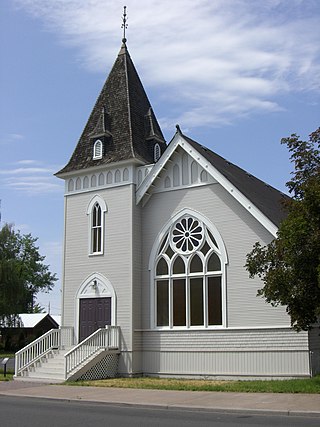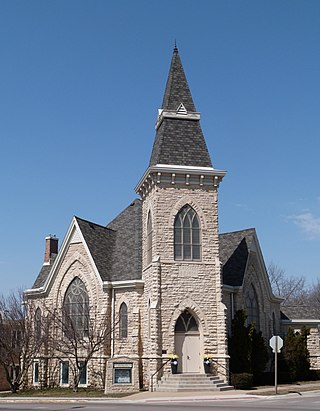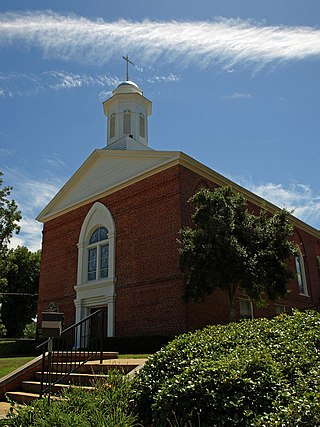
Second Presbyterian Church is a landmark Gothic Revival church located on South Michigan Avenue in Chicago, Illinois, United States. In the late nineteenth and early twentieth centuries, some of Chicago's most prominent families attended this church. It is renowned for its interior, completely redone in the Arts and Crafts style after a disastrous fire in 1900. The sanctuary is one of America's best examples of an unaltered Arts and Crafts church interior, fully embodying that movement's principles of simplicity, hand craftsmanship, and unity of design. It also boasts nine imposing Tiffany windows. The church was listed on the National Register of Historic Places in 1974 and later designated a Chicago Landmark on September 28, 1977. It was designated a National Historic Landmark in March 2013.

Carpenter Gothic, also sometimes called Carpenter's Gothic or Rural Gothic, is a North American architectural style-designation for an application of Gothic Revival architectural detailing and picturesque massing applied to wooden structures built by house-carpenters. The abundance of North American timber and the carpenter-built vernacular architectures based upon it made a picturesque improvisation upon Gothic a natural evolution. Carpenter Gothic improvises upon features that were carved in stone in authentic Gothic architecture, whether original or in more scholarly revival styles; however, in the absence of the restraining influence of genuine Gothic structures, the style was freed to improvise and emphasize charm and quaintness rather than fidelity to received models. The genre received its impetus from the publication by Alexander Jackson Davis of Rural Residences and from detailed plans and elevations in publications by Andrew Jackson Downing.

Church Street United Methodist Church is a United Methodist church located on Henley Street in downtown Knoxville, Tennessee. The church building is considered a Knoxville landmark and is listed on the National Register of Historic Places.

Government Street Presbyterian Church in Mobile, Alabama is one of the oldest and least-altered Greek Revival church buildings in the United States. The architectural design is by James Gallier Sr., James H. Dakin, and Charles Dakin. The trio also designed Barton Academy, four blocks down Government Street to the west. Government Street Presbyterian reflects the influences of Ithiel Town, Minard Lafever, and Andrew Jackson Downing. It was declared a National Historic Landmark in 1992.

The Orleans County Courthouse Historic District is one of two located in downtown Albion, New York, United States. Centered on Courthouse Square, it includes many significant buildings in the village, such as its post office and churches from seven different denominations, one of which is the tallest structure in the county. Many buildings are the work of local architect William V.N. Barlow, with contributions from Solon Spencer Beman and Andrew Jackson Warner. They run the range of architectural styles from the era in which the district developed, from Federal to Colonial Revival.

The First Presbyterian Church in Batavia, New York, United States, is located at East Main and Liberty streets. It is a joined complex of several buildings. The main one, the church's sanctuary, is a limestone Gothic Revival structure built in the mid-19th century. Its congregation was the first church to be organized in Batavia, albeit as a Congregationalist group at that time.

Built in 1912, the First Presbyterian Church of Redmond is the oldest standing church structure in the city of Redmond, Oregon, United States. It is also the second-oldest religious building in Deschutes County. The church was built in the Gothic Revival style with Queen Anne architectural detailing. It was the home of Protestant congregations from 1912 until 1979. Today, the building is privately owned and used as a special events venue. The First Presbyterian Church of Redmond was listed on the National Register of Historic Places in 2001.

The Briceville Community Church is a nondenominational church located in Briceville, Tennessee, United States. Built in 1887, the church served as a center of social life and community affairs for the Coal Creek Valley during the valley's coal mining boom period in the late-19th and early-20th centuries. In 2003, the church was added to the National Register of Historic Places for its historical role and as an example of rural Gothic Revival architecture.

Clear Springs Cumberland Presbyterian Church is a historic church of the Cumberland Presbyterian denomination in McMinn County, Tennessee, about 6 miles (9.7 km) southeast of Calhoun. The church building, which is no longer in use, is listed on the National Register of Historic Places.

First Presbyterian Church is located in Marion, Iowa, United States. It was listed on the National Register of Historic Places in 1992.

Vernal Presbyterian Church is a historic church near Lucedale, Mississippi in the unincorporated community of Vernal.

The Lowndesboro Historic District is a historic district in Lowndesboro, Alabama, United States. It was placed on the National Register of Historic Places on December 12, 1973. The district covers 1,800 acres (730 ha), spread over the entire town, and contains 20 contributing properties, including Meadowlawn Plantation. Architectural styles include the Gothic Revival, Greek Revival, and other Victorian styles.

The First Methodist Episcopal Church, also known as the Red Church, is a historic church located at 4451 Second Street in Port Hope, Michigan. It was listed on the National Register of Historic Places in 1987.

Oakey Streak Methodist Episcopal Church is a historic church in Butler County, Alabama. The congregation was organized in 1831, and the land where the current church sits was given to the church in 1851. A log building was erected soon after, replaced by the current frame structure around the 1880s. The church was expanded and a bell tower was added in 1903. Along with the adjacent Masonic Lodge, which was demolished in the 1940s, the church was the social center of the area.

First Baptist Church Of Wetumpka is a Baptist church complex at 205 West Bridge Street in Wetumpka, Alabama. It is affiliated with the Southern Baptist Convention. It consisted of several connected buildings, centered on an original brick sanctuary building that was built from 1846 to 1852. The original sanctuary was slated for demolition by May 2020 following tornado damage. The grounds also include 1928–29 educational building, a 1959–60 second educational and office addition, a modern sanctuary built in 1967, and educational wing and fellowship hall that was completed in 1991. All of the buildings are centered on the original sanctuary and are linked together by a series of passages and corridors at the rear of the property. The original sanctuary was added to the Alabama Register of Landmarks and Heritage in 1977 and the National Register of Historic Places in 2008.

The New Market Historic District is a historic district in New Market, Alabama. The town was founded in the 1820s as a trade center along the road between Huntsville and Winchester, Tennessee. The town incorporated in 1837, and had grown to around 500 residents by the 1850s. Although much of the town was destroyed in the Civil War, some antebellum structures survive, including Classical Revival houses built in 1854 and 1860, and the Whitman-Cobb House built circa 1861.
First Presbyterian Church is a historic Presbyterian Church in America congregation in Uniontown, Alabama. The church was founded in 1848 as Hopewell Presbyterian Church. In 1853 the church merged with Coffee Spring Cumberland Presbyterian Church, which was also organized in 1848 and was meeting in a building three miles south of Uniontown. In 1854, the congregation moved into their first church building on Green Street. Services were held here for half a century until their current church was built on Water Avenue. The present building was dedicated in 1914. The window in the center of the north wall of the sanctuary is from the previous church. The pulpit chairs in the church are also from the church on Green Street. The First Presbyterian Church building is listed on the National Register of Historic Places (NRHP), added on February 24, 2000, as a contributing property to the Uniontown Historic District.
Woodlawn, Alabama is a community in Jefferson County, Alabama, which is now a neighborhood within the city of Birmingham, Alabama. It grew as an independent community, and became the City of Woodlawn, and built a substantial City Hall building in 1908, but was annexed by Birmingham in 1910. The community area experienced a surge of growth after it was annexed.

Truman I. Lacey (1834–1914) was an American architect in practice in Binghamton, New York from 1872 until 1914.























